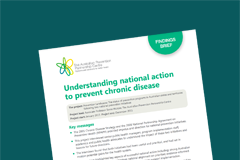Understanding national action to prevent chronic disease
This project found both the 2005 Chronic Disease Strategy and 2008 National Partnership Agreement on Preventive Health had been useful and set in motion potential health gains. Download our Findings Brief PDF for further insights for policy and practice.
Key messages
- The 2005 Chronic Disease Strategy and the 2008 National Partnership Agreement on Preventive Health (NPAPH) provided impetus and direction for national prevention initiatives.
- This project interviewed senior public health managers, program implementation staff, academics and public health advocates to understand the impact of these two initiatives and lessons for future directions.
- The interviews found that both initiatives had been useful and practical, and had set in motion potential gains for the health system.
- The interviews highlighted key aspects of successful national action including: strong Australian Government leadership and coordination; national alignment on priorities; evidence-informed implementation strategies; and funding and infrastructure to support implementation.
- The 2005 Chronic Disease Strategy was viewed as necessary for national coordination and to align priorities and action across states and territories, but without funding, infrastructure or an implementation plan, its achievements were limited.
- The NPAPH was seen as well on its way to achieving its goals, but it needed more time, stronger national leadership and an overarching national strategy to reach its potential.
